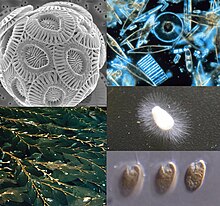
Back Chromalveolata ALS طلائعيات ملونة موسدة Arabic طلائعيات ملونه موسده ARZ Chromalveolata Bulgarian Cromalveolats Catalan Chromalveolata Czech Chromalveolata Danish Chromalveolata German Chromalveolata Spanish Kromalveolaadid Estonian
| Chromalveolata | |
|---|---|

| |
| Clockwise from top-left: a haptophyte (coccolithophore: Emiliania huxleyi), some diatoms, a water mold, a cryptomonad, and Macrocystis, a phaeophyte | |
| Scientific classification | |
| Domain: | Eukaryota |
| (unranked): | Bikonta |
| (unranked): | Chromalveolata Adl et al., 2005 (not a monophyletic group)[1][2] |
| Phyla | |
Chromalveolata was a eukaryote supergroup present in a major classification of 2005, then regarded as one of the six major groups within the eukaryotes.[3] It was a refinement of the kingdom Chromista, first proposed by Thomas Cavalier-Smith in 1981. Chromalveolata was proposed to represent the organisms descended from a single secondary endosymbiosis involving a red alga and a bikont.[4] The plastids in these organisms are those that contain chlorophyll c.
However, the monophyly of the Chromalveolata has been rejected. Thus, two papers published in 2008 have phylogenetic trees in which the chromalveolates are split up,[5][6] and recent studies continue to support this view.[7][8]
- ^ Laura A. Katz; Jessica R Grant (23 December 2014). "Taxon-rich phylogenomic analyses resolve the eukaryotic tree of life and reveal the power of subsampling by sites". Systematic Biology. 64 (3): 406–415. doi:10.1093/SYSBIO/SYU126. ISSN 1063-5157. PMID 25540455. Wikidata Q28254627.
- ^ Cavalier-Smith, Thomas; Chao, Ema E.; Lewis, Rhodri (2015-12-01). "Multiple origins of Heliozoa from flagellate ancestors: New cryptist subphylum Corbihelia, superclass Corbistoma, and monophyly of Haptista, Cryptista, Hacrobia and Chromista". Molecular Phylogenetics and Evolution. 93: 331–362. Bibcode:2015MolPE..93..331C. doi:10.1016/j.ympev.2015.07.004. PMID 26234272.
- ^ Adl, Sina M.; et al. (2005). "The New Higher Level Classification of Eukaryotes with Emphasis on the Taxonomy of Protists". Journal of Eukaryotic Microbiology. 52 (5): 399–451. doi:10.1111/j.1550-7408.2005.00053.x. PMID 16248873. S2CID 8060916.
- ^ Keeling PJ (2009). "Chromalveolates and the evolution of plastids by secondary endosymbiosis". J. Eukaryot. Microbiol. 56 (1): 1–8. doi:10.1111/j.1550-7408.2008.00371.x. PMID 19335769. S2CID 34259721.
- ^ Burki, Fabien; Shalchian-Tabrizi, Kamran & Pawlowski, Jan (2008). "Phylogenomics reveals a new 'megagroup' including most photosynthetic eukaryotes". Biology Letters. 4 (4): 366–369. doi:10.1098/rsbl.2008.0224. PMC 2610160. PMID 18522922.
- ^ Kim, E.; Graham, L.E. (Jul 2008). Redfield, Rosemary Jeanne (ed.). "EEF2 analysis challenges the monophyly of Archaeplastida and Chromalveolata". PLOS ONE. 3 (7): e2621. Bibcode:2008PLoSO...3.2621K. doi:10.1371/journal.pone.0002621. PMC 2440802. PMID 18612431.
- ^ Cite error: The named reference
Burki2012was invoked but never defined (see the help page). - ^ Burki, Fabien; Kaplan, Maia; Tikhonenkov, Denis V.; Zlatogursky, Vasily; Minh, Bui Quang; Radaykina, Liudmila V.; Smirnov, Alexey; Mylnikov, Alexander P.; Keeling, Patrick J. (2016-01-27). "Untangling the early diversification of eukaryotes: a phylogenomic study of the evolutionary origins of Centrohelida, Haptophyta and Cryptista". Proc. R. Soc. B. 283 (1823): 20152802. doi:10.1098/rspb.2015.2802. ISSN 0962-8452. PMC 4795036. PMID 26817772.
© MMXXIII Rich X Search. We shall prevail. All rights reserved. Rich X Search